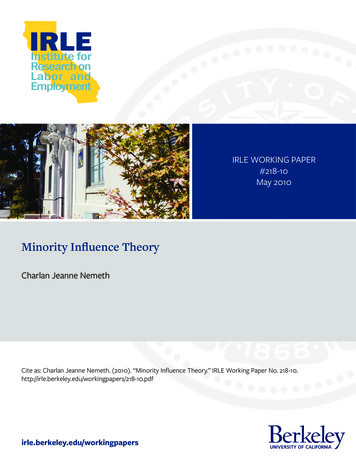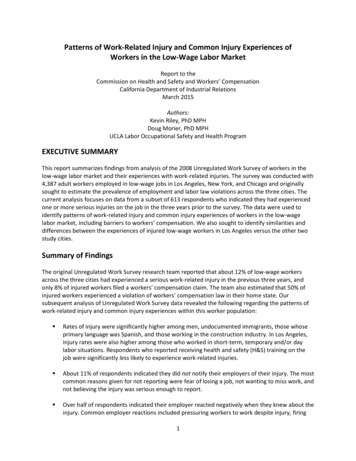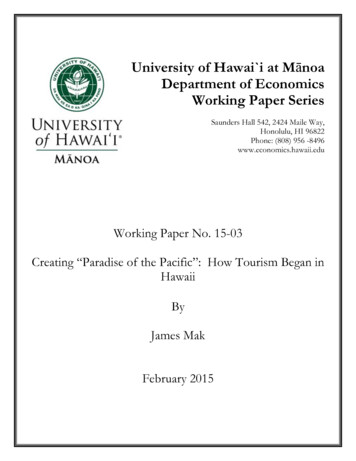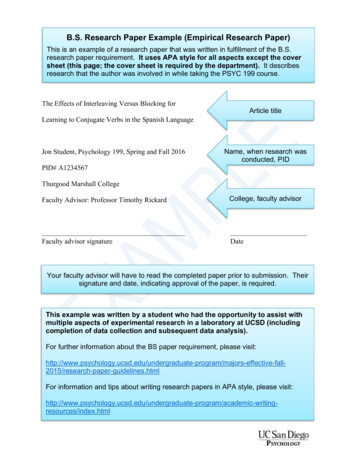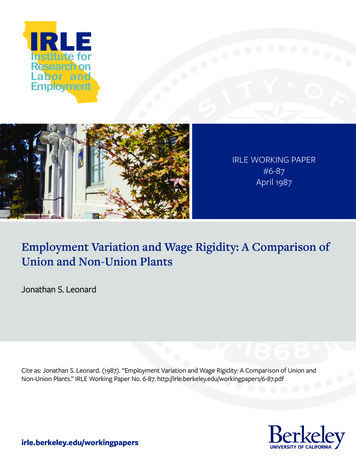
Transcription
IRLEIRLE WORKING PAPER#6-87April 1987Employment Variation and Wage Rigidity: A Comparison ofUnion and Non-Union PlantsJonathan S. LeonardCite as: Jonathan S. Leonard. (1987). “Employment Variation and Wage Rigidity: A Comparison of Union andNon-Union Plants.” IRLE Working Paper No. 6-87. e.berkeley.edu/workingpapers
Institute for Research on Labor andEmploymentUC BerkeleyTitle:Employment Variation and Wage Rigidity: A Comparison of Union and Non-Union PlantsAuthor:Leonard, Jonathan S., University of California, BerkeleyPublication Date:04-01-1987Series:Working Paper SeriesPublication Info:Working Paper Series, Institute for Research on Labor and Employment, UC 1qn6g5bcKeywords:Leonard, Employment Variation, wage rigidity, union, non-unionAbstract:The unionized sector is often thought of as the dominant focus of wage rigidity and henceemployment instability in Keynesian models that attribute unemployment to rigid wages. Wherethe price mechanism is frozen, quantity changes are amplified. This paper compares intertemporalemployment variability during the 1970's at union and non-union plants, and finds no greatercyclical or residual employment variation in union than in non-union plants.Copyright Information:All rights reserved unless otherwise indicated. Contact the author or original publisher for anynecessary permissions. eScholarship is not the copyright owner for deposited works. Learn moreat http://www.escholarship.org/help copyright.html#reuseeScholarship provides open access, scholarly publishingservices to the University of California and delivers a dynamicresearch platform to scholars worldwide.
EMPLOYMENT VARIATION AND WAGE RIGIDITY:A COMPARISON OF UNION AND NON-UNION PLANTSJonathan S. LeonardNational Bureau of Economic ResearchandUniversity of California, BerkeleyFebruary 1986I have benef-itted from discussions with Zvi Griliches. I thank Bill Dickens,Richard Freeman, Jeff Zax, Kevin Lang, John Ham, and participants in seminarsat Harvard, M.I.T. and Princeton for their comments. Points of view oropinions stated here do not represent the official policy or position of anyagency of the U.S. Government, the State of California, or of any of thepeople thanked above, some of whom differ with my interpretation. 1985 Jonathan S. Leonard
MarchH31986AbstractThe unionized sector is often thought of as the dominant focus of wagerigidity and hence employment instability in Keynesian models that attributeunemployment to rigid wages. Where the price mechanism is frozen, quantitychanges are amplified. This paper compares intertemporal employmentvariability during the 1970's at union and non-union plants, and finds nogreater cyclical or residual employment variation in union than in non-unionplants.Jonathan S. LeonardSchool of BusinessUniversity of California at BerkeleyandNBER-Olin FellowNational Bureau of Economic ResearchCambridge, MA 02138(617) 868-3900
I.INTRODUCTIONDoes employment vary more over time in union than in non-union plants?The question is of fundamental importance to macroeconomic theories thatexplain unemployment as a result of rigid wages, typically holding theunionized sector up as the prime example.All companies face some element of fluctuation in their product demand.When product demand falls, the derived demand for labor will also usuallyfall. The firm can adjust by laying off workers, by cutting wages, or bywork-sharing, (hours reduction) among other ways. Where the price mechanismis frozen, one might expect greater fluctuation in quantities.This paper compares employment variability and turnover at union and nonunion plants. It asks whether employment is more unstable across years inunion plants compared to non-union plants. Does this reflect differences inproduct demand volatility, in employer policy, or in union preferences? Dothe differences correspond with those predicted by the monopoly model or theefficient contract model of unionism?To implement these tests of labor demand at a disaggregated level, thispaper uses new data on a panel of manufacturing plants between 1969 and 1981.Unlike previous analysis, I shall be directly concerned here with the secondmoments of individual observations:the variance over time in employment(labor demand) within plants. This will then be split into cyclical andresidual components.The following section draws hypotheses concerning employment variationfrom two models of industrial unions — the monopoly union model and theefficient contract model, and compares these with what would be expected froma spot market in labor. The third section reviews some of the literature on
-2-union effects on employment and layoffs.Section IV presents some basiccomparisons of employment variation and the transience of change by unionstatus. Section V presents the main results comparing the intertemporalvariation in employment across union and non-union plants. The likelihood ofidentifying a true union effect is strengthened first by comparing whitecollar workers with blue-collar workers within plants, and second byestimating individual union effects. The sixth section is an aside thatdevelops the implications of slower employment growth in union plants forexplaining the decline in the proportion of the work force organized. SectionVII examines the channels of differential employment variation, comparingtermination, new-hire, and promotion rates at union and non-union plants. Theeighth section presents conclusions, followed by an appendix that describesthe data-set constructed for this study.II.WAGE-SETTING, AND EFFICIENT CONTRACTS MODELS OF UNIONSThese are two major ways to think about unions that carry relevent anddivergent implications for employment stability. See Oswald, 1985, for areview of these models.The first is a standard monopoly model of unions inwhich the union sets a fixed wage for the duration of the contract.Employment is then determined by the firm's labor demand schedule. Suchrigid-wage models have been commonly used as a basis for upward slopingaggregate supply schedules. This standard model yields the testablehypothesis that employment variation is amplified in the union compared tonon-union sector because of relative wage rigidity. This assumes that wages
-3-decline if labor demand falls in non-union plants. A finding of no greateremployment variation is subject to at least the following additionalinterpretations, all still within the context of the monopoly model: 1} forsome reason (such as efficiency wages or long-term implicit contracts), wagesare also rigid in the non-union sector; 2) firms have foresight in theirselection of products, markets and output contracts. A risk averse unionizedfirm realizes it is constrained by rigid factor prices, so selects itself intocustomer contracts with fixed output prices for positive output for a matchingperiod. This is analogous to financial market models in which exposure toprice level fluctuations is minimized by matching credit and debit maturities.3) National unions have foresight.They select stable plants for unionorganization.The second major model of unions arises from the efficient contractsliterature. To take a polar case, think of the union and the company sharingrents.* It is in their joint interest to maximize the pool of rents availablefor sharing, and so to use inputs with first-best efficiency (Hall & Li lien,1979). The quantity of labor used in production will then be identical tothat called for by competitive market wages. Contract wages are then just anaccounting device, and their presumed rigidity has no implication foremployment variation. Since the union share of rents is taken as a pureincome transfer, this strong-form efficient contract model yields the testablehypothesis that employment variation does not differ because of the presenceof a union.With homogenous union members, strong form efficiency (rent maximization)requires union members to be indifferent concerning the level of employment.
-4-Income redistribution from employed to unemployed union members would besufficient to accomplish this, but this is implausible because institutionallysuch direct redistributive measures are rarely observed (Oswald, 1984).Exceptions are found in the supplemental unemployment benefits contained incollective bargaining agreements negotiated by the United Auto Workers and theUnited Rubber Workers. A second more direct exception may be found in pensionbenefits, especially under early retirement schemes adopted during recessions.Union members are, however, not homogenous. In particular, theytypically have (endogenous) well-defined seniority rights. Oswald (1984) usesthe institutional fact that layoffs are typically in order of reverseseniority (last-in first-out) to argue that efficient contracts are on thedemand curve because the median union member will be indifferent to higherlevels of employment. The dynamic properties of this model are unclear —some deus-ex-machina long-term contract enforcement mechanism is needed tokeep successive median voters from marching up the demand curve until theyleave only the Cheshire Cat smile on the faces of the last two unionmembers who sell out the third for higher wages. An alternative approachmakes use of the fact that recalls are also commonly by seniority, so ifsteady-state employment is constant and capital markets work, only the presentvalue of life-time earnings and leisure matters, and union members areindifferent toward short-run fluctuations in employment.
-5-III. PAST STUDIES OF UNION EFFECTS ON EMPLOYMENT STABILITYThe impact of unions on employment stability, and hence on unemployment,appears to be a balance between competing forces. Temporary layoffs arerelatively more prevalent in the union sector compared to the non-union sectorduring cyclical down-turns because unions restrict the use of alternativeadjustment mechanisms such as wage cuts or work-sharing and because the quitrate is generally lower under unionism. Medoff (1979) has calculated layoffrates in the union sector of manufacturing to be 2.2 to 4.6 times greater thanin the non-union sector, and layoff unemployment 1.5 to 1.6 times greater.Onthis basis we would expect employment variation to fluctuate more violently inthe union sector, in response to a given level of product demand variation.There'is also some evidence that product demand variation itself is greater inthe union sector of manufacturing. Freeman and Medoff (p. 113) citeunpublished work that estimates that the variation in shipments over thebusiness cycle is nearly twice as large in heavily unionized as in lightlyunionized industries.In contrast to the earlier work by Medoff, the morerecent analysis by Freeman and Medoff is reported to find no significantdifference in the response to a given change in shipments.Under certain restrictive conditions, the mean tenure of employed workersmay also contain information on the history of employement fluctuations withinplants, although the connections are quite complex.For example, if workersnever quit and were always discharged in reverse seniority order (last in,first out), and if plants experienced no net growth or shrinkage, then one caninfer, although still in a limited sense, that a plant with a higher average
-6-tenure among its workers has experienced less employment variation. Freeman(1980) reports higher average tenure among union workers, but the preciseinterpretation depends on other factors such as those discussed above.There is also evidence that permanent layoffs are no more prevalent amongunion than non-union workers and that unemployment due to permanent layoff islower among union workers (Freeman and Medoff, 1984, pp. 118-120). Thissurprising finding will be explored further here.The interpretation of the results to be presented here will dependcritically on how rigid union wages are relative to non-union wages, and onhow both of these compare to a spot market. Abowd and Card (1984, Table 3)report a set of statistics from which one can derive the variance of theannual change in the logarithm of earnings in longitudinal samples. Insamples from both the PSID and the NLS, they find 24 to 38 percent greatervariation in the change in wages of non-union than of union workers between1967 and 1979. Freeman and Medoff (1984, p. 272, n. 5) report elasticities ofreal wages with respect to real shipments of .02 in unionized industries andof .12 in non-union industries in quarterly data between 1958 and 1975. Bothstudies agree in finding relatively rigid wages in the union sector, but theFreeman and Medoff results indicate that wages respond inelastically to demandshifts in both sectors.Empirical tests of efficient contract models have begun to develop in thelast few years. Most have examined the behavior of one. union, thetypographers.The results so far have been imprecise, mixed, and heavilydependent on auxiliary identifying assumptions.See Ashenfelter and Brown(1983), Card (1984), Carruth and Oswald (1983), Dertouzos and Pencavel (1981),
-7-Farber (1978a, 1978b), MaCurdy and Pencavel (1983), Martinello (1984),Pencavel (1983a, 1984b), and Svejnar (1982). Nevertheless, it seems fair toconclude from these studies that generally trade unions act as if bothemployment and wages mattered.(See Pencavel (1985) for a review.) Againstthis we must hold the finding (Oswald, 1984) that few unions admit to havingeither formal or informal agreements with employers concerning employmentlevels.The overall picture suggested by this literature is of unions that arenot indifferent about employment levels, and of a union sector with relativelygreater temporary layoffs, relatively fewer quits, but comparable permanentlayoffs. This paper will focus on union effects on long-term employmentvariability, as well as on promotions, new hires, and total terminations.Employment may vary more in the union sector, either because product demand ismore variable, or more likely because alternative responses to a given productdemand shock are relatively restricted in the union sector. The next sectionattempts to distinguish between these two explanations without the aid ofdirect measures of product demand variability or of real wage rigidity.IV.EMPLOYMENT VARIATION IN UNION AND NON-UNION PLANTSIs employment more stable in non-union plants than in union plants? Theevidence to be presented in this section offers some support for thishypothesis, although many of the differences are small. This section presentssome basic evidence of size, industry and transient effects.California manufacturing plants are observed over 5 consecutive years in
-8-rolling time-frames between 1969 and 1981. The standard-deviation of totalemployment within a plant across time is 714 in union plants, greater than the521 observed in non-union plants (see Appendix for description of data). Onlyplants with positive total employment for five years are included in thesample, so employment variation due to births or deaths is not measured here.If the type of variation union plants face is more likely to drive them out ofbusiness, evidence drawn from this sample may give a downward biased pictureof total employment change in union plants.Mathematically, the standard deviation increases with scale (VAR(Xx) 2X VAR(x)), so these measures are contaminated with scale effects. Since theunion plants average 1539 employees over these years, compared to 1246 in thenon-union plants, the (scale-free) coefficient of variation is also marginallygreater in the union plants, .46 compared to .42.The coefficient ofvariation is rather clumsy to use, so the remainder of this paper shall usethe logarithm of size. This has two advantages.First, it is more natural tothink of plants changing in equal proportion to their size than in equalabsolute numbers.Second, VAR(log(Xx)) * VAR(log x) where X is a constant, sothe logarithm measure is scale free.Variation in employment within union plants compared to non-union plantsmay be examined at a basic level by calculating the correlation of employmentwithin plants over time. Table 1 presents such correlation matrices of thelogarithm of plant size over 5 consecutive years separately for union andnon-union plants. This table shows that employment variation has beenslightly greater in union plants than in non-union plants within themanufacturing sector of one state.The correlation of plant sizes in
-9-neighboring years ranges from .97 to .99 in non-union plants.identical in union plants, .97 to .98.It is nearlyThe differences are also negligibleover 5 years. The correlation between (early) year 1 and (recent) year 5employment is .93 among non-union plants, compared to .92 among union plants.Over the same 5 years absolute employment in the non-union plants grows by17%, compared to only 1% in the union plants,2 a finding we shall return to.The median and mode period of observation is from 1972 (year l) to 1976(year 5) in both the union and non-union subsamples. The distribution isshown in Table A. Obviously, as one would expect with any sort of businesscycle, the correlation matrix is not stationary but rather the correlationsvary by calendar year.For example, the lowest first order correlation isfound between year 2 and year 3 — corresponding to 1973 and 1974 — in theunion sub-sample (but not in the non-union subsample). Note also that thehigher order correlations are close to integer multiples of the first ordercorrelations, as would be predicted by a first-order autoregressive process.This is.inconsistent with a simple fixed effect model which would predictidentical correlations for every pair of years. The usefulness of past plantsize for predicting future size decays as time passes.Although union plants grow slower than non-union plants, they appear toexperience slightly greater employment variation. As time passes, thecorrelation of current employment within plants with employment in any givenpast year declines, and it declines faster in union plants than in non-unionplants.The slower growth of union plants may be due to higher wages. Thegreater employment variation may well reflect more rigid wages in the unionsector, since it is unlikely that the variability of product demand differs
-10-greatly across union and non-union plants within the manufacturing sector inthe one state considered here.Stronger empirical support for this view could be developed by directlymeasuring product demand variation in the two sectors. An alternativeapproach examines highly disaggregated sectors whose products are perhaps morelikely to face highly correlated demands across plants. Within a detailedindustry, for a specific region and year, do we still observe greatervariation in union plants? Table 2 replicates the correlation matrices ofTable 1 for residuals from regressions of the logarithm of plant size onindustry, region, and calendar year.This helps to isolate the union effect.The correlation between plant size 5 years apart is .87 in the union plants,less than the .93 observed in non-union plants. Within disaggregatedindustries, regions, and periods of time, the variation of employment overtime is greater in union than in non-union plants. One would also like to seeother characteristics of these plants controlled for and other measures ofemployment variation, as we shall turn to in the next section.It ispossible, but unlikely, that this difference in employment variation could beexplained by greater product demand variation faced by the union plants inthis sector. It is more likely that this greater employment variationreflects either 1) more rigid wages and staffing procedures in the unionsector that result in greater employment variation for a given product demandvariation, or 2). the effects of omitted plant characteristics, such as size.Do the changes in plant size observed here largely reflect trend growthor transient shocks and measurement error?There appears to be little trendin growth rates across years relative to transient shocks, in the sense that
-11plants with above average growth in one year don't enjoy similar success inlater years. The correlation matrices of growth rates across time withinplants in the union and non-union subsamples are presented in Table 3. Atbest, half of the correlations are significant, and all the significantcorrelations are negative.The best bet after seeing a plant grow is that itwill shrink (relative to group average).evidence.)(See Leonard (1984b) for furtherThere is some suggestion in Table 3 that union plants take longerto turn around.This new evidence comparing employment volatility in the union andnon-union sectors also suggests that past evidence indicating higher tenurefor union than for non-union workers may tell only part of the story. How canit be true that union workers have higher tenure than non-union workers, yetemployment undergoes greater fluctuations in union plants?The data on tenurerefers only to uncompleted spells of employment. A conceptually distinctmeasure of tenure would compute the average duration of employment for allworkers who had been employed in a plant. While this distinction has beenfruitfully applied in the past to unemployment durations (see Salant, Kaitz,Akerlof and Main), it has not been applied to the union tenure effect. Whileit may well be true that the average worker currently employed in a unionplant has greater tenure than his non-union counterpart, it may also be truethat the average completed spell of employment observed in the union sector isshorter than its non-union counterpart.The workers who are not permanentlydisplaced by the greater employment variation we observe in the union plantsremain on their jobs and accumulate the higher tenure usually observed. Theworkers who are displaced are not counted in these uncompleted spell measures
-12-of tenure, but, by the nature of union seniority clauses, would contribute tolower completed spell measures of tenure.V.REGRESSION TESTS OF THE UNION EFFECT ON EMPLOYMENT VARIATIONThe results of the last section have the weaknesses as well as thestrengths of simplicity. What little additional employment variation there isat union plants is of a nature that may not readily be explained by greatervariation in demand for the products of unionized plants. The weakness ofsuch simple tests is their failure to control for other differences betweenunion and non-union plants — size in particular. This section presentsregressions of two different measures of inter-temporal employment variation ona vector of detailed plant characteristics and first finds that totalemployment in union plants, measured from year to year, is generally as stableas in non-union plants, ceteris paribus. A second measure splits thisvariation more finely into cyclical changes and a residual, and finds lesscyclical and residual variation in the union sector. This effect is thencompared across white-collar and blue-collar workers, and across individualunions.The first problem is to disentangle the union growth effect from theunion variation effect. A plant in steady growth or decline will show agreater raw variance than one with constant employment.Since union plantshave lower growth rates than non-union plants, it is desirable to compare thevariation in employment about trend to differentiate from trend growtheffects. Let S- t be the logarithm of total employment in plant i in year t.The raw variance is of course:
-13- l Vi Et l(Sit- §i)2/4Now consider the N time-series regressions:S.t a. /3.Tt * e.t(2)i 1,N t 1,5where T time trend [-2, -1, 0, 1, 2], and the errors are assumed to beindependently and identically distributed (no serial correlation). Detrendedsize is simply the residual from this regression, or:S.t . S.t - (a. 0.Tt](3)Note that an additional degree of freedom for each observation has been usedup in detrending. The variance of detrended employment is then:The square root of this gives a measure of the mean proportional detrendedchange.Union plants do differ from non-union plants in a number of major aspectsbesides unionism itself, as Table 4 shows for the California manufacturingsample. Detrending should reduce the variance of non-union plants more thanthat of union plants because union plants' unweighted annual average growthrate is only 3.7%, compared to the non-union 5.6%.Also of particular concernhere, the sample union plants are more than half again as large as thenon-union plants. This is important because past studies of employmentvariation suggest that changes are proportional to absolute size. With suchscale effects, the variance of the logarithm of size need not increase with
-14-size even though the variance of absolute size does. The union plants arealso more likely than non-union plants to be part of largermulti-establishment companies.The proportions of craftsmen, operators,laborers and service workers, and of clerical workers are higher in unionplants. The union plants are relatively more likely than non-union plants tobe found in the two major SMSAs of Los Angeles and San Francisco than inoutlying, more recently developed areas.The union plants are also morelikely to be found in the following industries: printing, glass, machinery,»electrical equipment (except SIC 367), and transportation equipment. Thissample includes more than 700,000 employees, or more than a third of all theemployees in California manufacturing. The effects of shocks that are commonacross plants such as the business cycle, may be interpreted in the context ofthe market, rather than the partial equilibrium of a single plant. In bothsectors, the median and mode period of observation is from 1972 to 1976.Thisperiod includes the turbulent time after the first "oil shock" — a classicperiod in which to examine the effects of rigid wages.Direct Tests of VariationTable 5 presents regressions of the raw and detrended intertemporalvariation in the annual logarithm of total employment within plants on avector of individual plant characteristics including union status, size andits square at initial year of observation, annual growth rate, corporatestructure, occupational structure, 8 dummies for period of observation, 17dummies for 2 or 3 digit SIC industry and 5 dummies for region.There is no significant difference in Table 5 in the employment stability
-15Iof union and non-union plants. Measured in terms of year to year variation intotal employment, union plants — despite their presumed greater wagerigidity — are just as stable as non-union plants. By this measure, thepresumed freezing of the price adjustment mechanism by unions does not resultin greater quantity fluctuation.The natural result that size changes tend to be in proportion to size canbe seen in Table 5 from the finding that the coefficients on size and its squareare insignificant. Growth still adds strongly and significant to variance,even to the variance of the detrended logarithm of employment.Most of the other plant characteristics have little significant impact.In contrast to other findings in a national sample, but as predicted by modelswith perfect capital markets, corporate structure makes little difference.Asone would expect from Oi-type models, non-clerical, white-collar employment isrelatively stabilized compared to blue-collar employment. The onlysignificant industry or region effects (not shown) are higher variances intransportation equipment, and in San Jose (a notably febrile market).What of the formidable oil shock itself? Does the battering it gave theU.S. economy show itself in greater employment instability within plants after1973? Curiously, there is no strong evidence of extraordinary post-shockturbulence here. Rather, the periods of greatest employment instability arethe observations from 1969 to 1973, and from 1977 to 1981 (second oil shock).Within plant employment variation actually declines significantly in between.This is both unexpected and unexplained.If this finding is not a fluke, itmay carry implications for thinking about the microeconomic response tomacroeconomic shocks.
-16-Pooled Time-Series Cross-Section Results on Change in LogarithmsAn alternative specification fits more comfortably into the time-seriescross-section framework and also allows for a more finely divided examinationof the the different cyclical sensitivities in union and non-union plants.Like all random walk models, of which this is a variant, this process impliesthat the variance of the size distribution increases without limit as timepasses. A convenient specification to be estimated separately for union andnon-union plants is:(5)d it o b DGNPt b DGNP bg §. Z. b e.whereditsSi,t-Si,t-lts2'5S. logarithm of employment in plant i in year tDGNP » change in log of real gross national product betweenyear t and year t-1.§i * Zt lSi,t /52.* A vector of plant characteristics in the initial year ofobservation (or time invariant), including industry,region, occupational and corporate structure.e.- error term, assumed serially and cross-sectionallyuncorellated, and normally distributed with mean zero.This is a regression, using pooled time-series cross-section data, of thefirst difference in the logarithm of size (the logarithm of the annual growthrate) of the i'th plant in between year t and year t-1 on a set of detailedplant characteristics. These controls include the mean logarithm of size, a
-17-set of industry and region dummies, controls for occupational and corporatestructure, and cyclical indicators.This equation yields a test on comparative variation when estimatedseparately for the union and non-union subsamples, by inspection of theresidual variances.If the detrended level of union employment is morevariable, then so must be the growth rate, and so the residual variance from aregression of
University of California, Berkeley February 1986 I have benef-itted from discussions with Zvi Griliches. I thank Bill Dickens, . The second major model of unions arises from the efficient contracts literature. To take a polar case, think of the union and the company sharing . accounting device, and their presumed rigidity has no implication for
